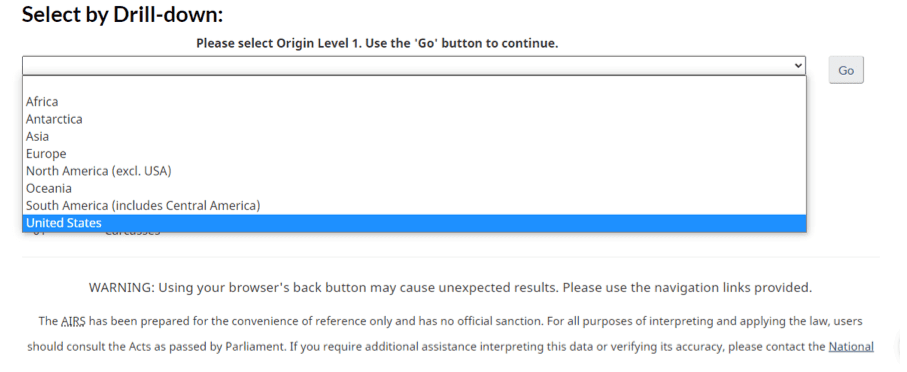On January 1, 2022, the 7th Edition of the Harmonized System (HS) nomenclature came into force. This update will affect Canadian importers and brokers who use the Automated Import Reference System (AIRS). HS codes may no longer be valid following HS structure updates by the World Customs Organization. If this is the case, a reject message “Invalid HS/OGD code” may appear upon searching the database. As Canada’s Food & Beverage experts, we will explain what CFIA AIRS is and answer your most-asked questions.
What Is the Automated Import Reference System?
AIRS is a free online database published by the Canadian Food Inspection Agency (CFIA) showing the import requirements of regulated food commodities in Canada. In this article, we’ll go through the basic steps of how to use the AIRS CFIA system to find information regarding food import requirements and how to interpret the results using the CFIA AIRS tool.
Step 1: Search by HS Code or Keyword
The easiest way to search in the AIRS CFIA tool is by HS code or by navigating the AIRS by using the drill-down menu options. Canada, as a member of the World Customs Organization (WCO), requires that all goods entering the country be declared by proper HS code to the Canada Border Service Agency (CBSA). Oftentimes, the importer or customs broker will learn which HS code to use for the imported food commodity.
However, in cases where there is some ambiguity of which HS code to use, requesting an advance ruling from the CBSA will help you gain certainty, especially when importing complex goods. The standard processing time for an advance ruling is 120 calendar days. For more information regarding advance ruling, please refer to the CBSA website.
In cases where HS codes aren’t readily available, you can also use keywords to search within the AIRS system. Once you click search, a drop-down menu lists all results by the numerical order of their HS codes. Meat and fish products appear at the top of the list. You will need to scroll down to select prepared foods and products such as beverages.
 Step 2: Drill-down Selections
Step 2: Drill-down Selections
Once you find the food description that is closest to the food item of interest, click the view on the right which will bring up a series of drill-down questions about the country of origin, end-use and other details about the goods.
Step 3: Summary of Requirements
After making your selections, you will come to the summary of requirements. The first section is a summary of the information you selected in the previous steps. The subsequent section, titled “Recommendations to CBSA/Documentation and Registration Requirements,” outlines the import requirements.
Based on the product information previously entered, you may find one of the following results:
- a. Refuse entry: this signifies that the product cannot be imported into Canada with the conditions selected. This doesn’t mean we cannot import this commodity at all. For example, if we search for lamb products from Egypt, the search result may be “Refuse entry.” However, this doesn’t mean we cannot import lamb at all. As a matter of fact, if we search for lamb from the United States, import is permitted providing the request is accompanied by an Official Meat Inspection Certificate.
- b. Safe food for Canadian (SFCR) License: If the result only reads “Safe food for Canadian License”, this means that the product is approved for import providing the Canadian importer holds a valid SFCR license, unless exempted. No additional supporting document is required by the CFIA.
- c. SFCR License accompanying other conditions: Additional requirements sometimes have to be met in order to import certain commodities. Below is a list of common supporting information or documents required to support the importation request:
- i. Foreign processing establishment: this denotes that the foreign manufacturer’s information (establishment number, activity code, company name and physical address) must be declared to the CBSA. This requirement applies to meat products.
- ii. Official Meat Inspection Certificate/Zoo Sanitary Certificate/Phytosanitary Certificate: Such certificates are issued by foreign authorities. Original copies are required at the time of import in order to release the products.
- iii. Import permit: For certain animal or animal by-products, a CFIA import permit is required. The importer or broker can apply for either an individual import permit or a multi-entry permit. Import Permits can be requested through MyCFIA.
- iv. DRC membership number: DRC stands for the Fruit and Vegetable Dispute Resolution Corporation, a non-profit organization that provides private commercial dispute resolution services to fruit and vegetable distributors. It is mandatory for anyone who sells more than $100,000 CAD of fresh fruit and vegetable within Canada to hold a valid DRC membership. For more information about DRC membership, please visit their website.
Step 4. Other Requirements for CFIA AIRS
When specific commodities are to be imported into Canada as per CFIA AIRS, there are still a few considerations you must take into account before shipping the container.
- Does your SFCR license include the food commodities you plan to import? If not, the importer must amend the SFCR license and list the correct commodities.
- Is the product in compliance? Whether the food product is approved in general by CFIA AIRS doesn’t mean that it meets the Canadian SFCR regulations. Regulations for food labelling, food additives and standards of identity can vary significantly from country to country. As a matter of fact, Canada and the US have different food regulations regarding food additives. For instance, certain food colouring agents are authorized for use in the United States but are banned in Canada. For more information, refer to the following article on food labels. In addition, the use of hormones and antibiotics in food-producing animals differs greatly between countries. If you’re unsure, you can contact a food safety regulatory specialist to navigate the import requirements that apply to your products.
- Do you have an importer preventive control plan (PCP)? Unless you qualify for an exemption, a Canadian importer must maintain a PCP importer plan to import food into Canada. Importers also have to declare that they have developed a written PCP plan when applying for an SFCR license. Where required, the CFIA AIRS will verify the effectiveness of the PCP plan by performing routine document reviews.
- Is there a tariff or quota that applies to the food you wish to import into Canada? Lastly, you want to check with your customs broker if there’s a tariff or an import quota for the food you wish to bring into Canada. You can also find information about tariffs on the CBSA’s website.
Get fully certified to secure the safety of your food supply chain with our help! Contact us today to learn more!
–Guest Blog Post author – Sean Xia (Food Safety Compliance Specialist)


 Step 2: Drill-down Selections
Step 2: Drill-down Selections




